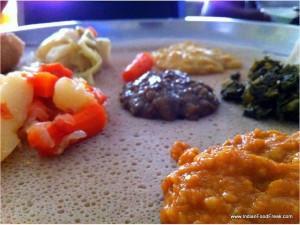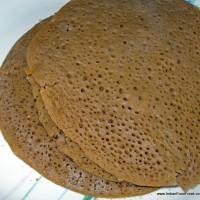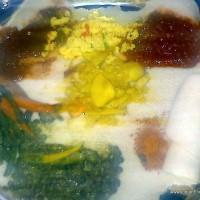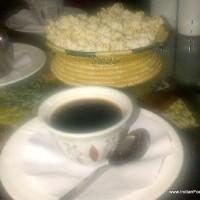[Rated: 4.0/5]

The restaurant is situated in a charming traditional building that houses the cultural center in the diplomatic district. We easily drive into the four-month-old Ethiopian cultural center and soon find our way to the restaurant which is called Blue Nile. The restaurant is a trifle boring looking unlike my expectations of finding a piece of Ethiopia in it. It has glass-topped tables and a selection of dals and whole spices under the glass (allegedly Ethiopian dals and spices but procured locally, the helpful server informs us), to give it a desi touch. I am even offered a choice of Ethiopian or Indian food by the Indian serving staff.

A

Eager for the authentic, I order the Ethiopian national dish doro wat (chicken cooked with special chilly and onion sauce), but alas all meaty wats are off the menu today. So on the server’s suggestion, I decide to go with begg alicha (Rs 470; mutton curry cooked with onion, garlic and ginger turmeric sauce), and begg tibs (Rs 415; mutton sliced fried with garlic, onion fresh chilly). This is served with rolled injeras. The curry is so near and yet so far from our Indian curries. The mutton is served on a large marrow bone with tons of marrow peaking out of the bone. The meat is yielding and the marrow sublime. The curry has an exotic flavour, though it is not as spicy as I would have preferred. This is soon rectified when I request the friendly wait staff from some chutney – he nods his head and comes back with (what I later discover) berbere, the most popular hot and spicy spice for Ethiopian cooking. It is a blend of red chili, garlic, salt and more. The meal certainly perks up once I start using it like our own gunpowder, along with injera. Begg tibs is dry, somewhat chewy, small bits of meat cooked with slices of capsicum and onions, with an interesting taste. What really decorates the meal is the soft, fluffy (like a flat appam, though more fermented and sour) injeras. I find them most addictive, and polish the last bit mopping the mutton curry with it.

So go on, have a meal of a cup of coffee with friends at the Blue Nile. Chances are that you will love it for its slice of exotica.
Ratings out of 5:
Food: 4.0 | Ambience: 3.5 | Service: 4.5 | Overall: 4.0
Meal for two: Rs. 1000| Alcohol: Yes | Credit Card: Yes | Timings: 12 noon to 3 PM, 6 PM to 10 PM| Address: 7/50, G Niti Marg (near Nehru Park), Chanakya Puri, New Delhi | Telephone: 24673654

